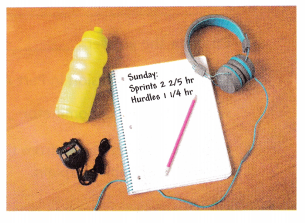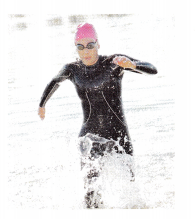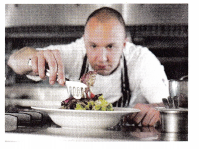We included HMH Into Math Grade 5 Answer Key PDF Module 7 Lesson 3 Assess Reasonableness of Mixed Number Sums and Differences to make students experts in learning maths.
HMH Into Math Grade 5 Module 7 Lesson 3 Answer Key Assess Reasonableness of Mixed Number Sums and Differences
I Can add and subtract mixed numbers with unlike denominators and assess reasonableness.
Step It Out
1. Caroline trains every weekend for a track and field competition. She writes down how long she spends running sprints and jumping hurdles. How many hours does she spend training on Sunday?

A. Write an expression to model the situation.
________________
B. Estimate the answer.
________________
C. Rewrite the expression in Part A using equivalent fractions with a common denominator. Then find the sum.
________________
D. How many hours does Caroline spend training on Sunday?
________________
E. Is your answer reasonable? Explain.
________________
Answer:
2\(\frac{2}{5}\) + 1\(\frac{1}{4}\)
Rewriting our equation with parts separated
2 + \(\frac{2}{5}\) + 1 + \(\frac{1}{4}\)
2 + 1 = 3
\(\frac{2}{5}\) + \(\frac{1}{4}\)
LCD is 20
\(\frac{8}{20}\) + \(\frac{5}{20}\) = \(\frac{13}{20}\)
3 + \(\frac{13}{20}\) = 3\(\frac{13}{20}\) hour
Turn and Tálk Describe how to find the sum of two mixed numbers. How can you determine if the answer is reasonable?
Step It Out
1. Jonah’s best pole vault jump is 7\(\frac{1}{4}\) feet. A sign in the gymnasium shows the gym’s record. How much shorter than the gym’s record is Jonah’s best jump?

A. Write an expression to model the situation.
__________________
B. Estimate the answer. __________________
C. Rewrite the expression in Part A using equivalent fractions with a common denominator. __________________
D. How far is Jonah’s jump from the gym’s record? Is your answer reasonable? Explain.
__________________
Answer:
Given,
Jonah’s best pole vault jump is 7\(\frac{1}{4}\) feet.
8\(\frac{7}{12}\) – 7\(\frac{1}{4}\)
Rewriting our equation with parts separated
8 – 7 = 1
\(\frac{7}{12}\) – \(\frac{1}{4}\)
LCD is 12.
\(\frac{7}{12}\) – \(\frac{3}{12}\) = \(\frac{4}{12}\) = \(\frac{1}{3}\) feet
Jonah’s is \(\frac{1}{3}\) feet far from the gym’s record.
Turn and Talk If you first expressed each of these mixed numbers as a fraction greater than 1, how would your method change?
Check Understanding Math Board
Question 1.
Jenna competes in the high jump. Her best jump in the first meet is 4\(\frac{1}{4}\) feet. Her best jump in the second meet is 4\(\frac{5}{6}\) feet. Write an expression using equivalent fractions with a common denominator to model how much the height of her jump increases. By how much does the height of her jump increase? Show that your answer is reasonable.
Answer:
Given,
Jenna competes in the high jump. Her best jump in the first meet is 4\(\frac{1}{4}\) feet. Her best jump in the second meet is 4\(\frac{5}{6}\) feet.
4\(\frac{5}{6}\) – 4\(\frac{1}{4}\)
Rewriting our equation with parts separated
4 + \(\frac{5}{6}\) – 4 – \(\frac{1}{4}\)
4 – 4 = 0
\(\frac{5}{6}\) – \(\frac{1}{4}\)
LCD is 12.
\(\frac{10}{12}\) – \(\frac{3}{12}\) = \(\frac{7}{12}\)
Jenna’s jump increased by \(\frac{7}{12}\) feet.
Write the expression using equivalent fractions with a common denominator. Then find the sum or difference.
Question 2.
2\(\frac{3}{5}\) + 1\(\frac{3}{10}\)
Answer:
2\(\frac{3}{5}\) + 1\(\frac{3}{10}\)
Rewriting our equation with parts separated
2 + \(\frac{3}{5}\) + 1 + \(\frac{3}{10}\)
2 + 1 = 3
\(\frac{3}{5}\) + \(\frac{3}{10}\)
LCD is 10
\(\frac{6}{10}\) + \(\frac{3}{10}\) = \(\frac{9}{10}\)
3 + \(\frac{9}{10}\) = 3\(\frac{9}{10}\)
Question 3.
3\(\frac{7}{8}\) – 1\(\frac{1}{2}\)
Answer:
3\(\frac{7}{8}\) – 1\(\frac{1}{2}\)
Rewriting our equation with parts separated
3 + \(\frac{7}{8}\) – 1 – \(\frac{1}{2}\)
3 – 1 = 2
\(\frac{7}{8}\) – \(\frac{1}{2}\)
LCD is 8.
\(\frac{7}{8}\) – \(\frac{4}{8}\) = \(\frac{3}{8}\)
2 + \(\frac{3}{8}\) = 2\(\frac{3}{8}\)
On Your Own
Question 4.
Donna trains for a triathlon. Her fastest times for the three parts of the event are: swimming (1\(\frac{1}{4}\) hr), running (1\(\frac{1}{2}\) hr), and biking (1\(\frac{1}{5}\) hr). If she matches her best times in all three parts, how long will it take her to finish the triathlon?

Answer:
Given,
Donna trains for a triathlon. Her fastest times for the three parts of the event are: swimming (1\(\frac{1}{4}\) hr), running (1\(\frac{1}{2}\) hr), and biking (1\(\frac{1}{5}\) hr).
1\(\frac{1}{4}\) + 1\(\frac{1}{2}\) + 1\(\frac{1}{5}\)
Rewriting our equation with parts separated
1 + 1 + 1 = 3
\(\frac{1}{4}\) + \(\frac{1}{2}\) + \(\frac{1}{5}\)
\(\frac{3}{4}\) + \(\frac{1}{5}\)
LCD is 20
\(\frac{15}{20}\) + \(\frac{4}{20}\) = \(\frac{19}{20}\)
3 + \(\frac{19}{20}\) = 3\(\frac{19}{20}\)
It takes around 4 hours to finish the triathlon.
Question 5.
Attend to Precision Richie estimates 1\(\frac{7}{8}\) – 1\(\frac{1}{6}\) to be about 1, but he finds the actual difference to be less than 1. Did he make a mistake? Explain.
Answer:
Given,
1\(\frac{7}{8}\) – 1\(\frac{1}{6}\)
Rewriting our equation with parts separated
1 + \(\frac{7}{8}\) – 1 – \(\frac{1}{6}\)
1 – 1 = 0
\(\frac{7}{8}\) – \(\frac{1}{6}\)
LCD of 8 and 6 is 24.
\(\frac{21}{24}\) – \(\frac{4}{24}\) = \(\frac{17}{24}\)
Find the sum or difference.
Question 6.
3\(\frac{5}{6}\) – 1\(\frac{7}{12}\)
Answer:
3\(\frac{5}{6}\) – 1\(\frac{7}{12}\)
Rewriting our equation with parts separated
3 + \(\frac{5}{6}\) – 1 – \(\frac{7}{12}\)
3 – 1 = 2
\(\frac{5}{6}\) – \(\frac{7}{12}\)
LCD is 12
\(\frac{10}{12}\) – \(\frac{7}{12}\) = \(\frac{3}{12}\)
2 + \(\frac{3}{12}\) = 2\(\frac{3}{12}\)
Question 7.
4\(\frac{1}{2}\) – 2\(\frac{1}{3}\)
Answer:
4\(\frac{1}{2}\) – 2\(\frac{1}{3}\)
Rewriting our equation with parts separated
4 + \(\frac{1}{2}\) – 2 – \(\frac{1}{3}\)
4 – 2 = 2
\(\frac{1}{2}\) – \(\frac{1}{3}\)
LCD is 6.
\(\frac{3}{6}\) – \(\frac{2}{6}\) = \(\frac{1}{6}\)
2 + \(\frac{1}{6}\) = 2\(\frac{1}{6}\)
Question 8.
5\(\frac{1}{3}\) + 3\(\frac{3}{7}\)
Answer:
5\(\frac{1}{3}\) + 3\(\frac{3}{7}\)
Rewriting our equation with parts separated
5 + \(\frac{1}{3}\) + 3 + \(\frac{3}{7}\)
5 + 3 = 8
\(\frac{1}{3}\) + \(\frac{3}{7}\)
LCD of 3 and 7 is 21.
\(\frac{7}{21}\) + \(\frac{9}{21}\) = \(\frac{16}{21}\)
8 + \(\frac{16}{21}\) = 8 \(\frac{16}{21}\)
Question 9.
2\(\frac{4}{9}\) + 1\(\frac{1}{4}\)
Answer:
2\(\frac{4}{9}\) + 1\(\frac{1}{4}\)
Rewriting our equation with parts separated
2 + \(\frac{4}{9}\) + 1 + \(\frac{1}{4}\)
2 + 1 = 3
\(\frac{4}{9}\) + \(\frac{1}{4}\)
LCD of 9 and 4 is 36.
\(\frac{16}{36}\) + \(\frac{9}{36}\) = \(\frac{25}{36}\)
Question 10.
Model with Mathematics Shaia buys a bag of apples that weighs 2\(\frac{7}{16}\) pounds, and another bag that weighs 2\(\frac{1}{2}\) pounds.
- Estimate the weight of both bags of apples. Then find the exact weight.
- Shaia also buys a bag of oranges that weighs 3\(\frac{5}{8}\) pounds. Write an expression to model how much more the bags of apples weigh than the bag of oranges. Then find the number of pounds.
Answer:
Given,
Shaia buys a bag of apples that weighs 2\(\frac{7}{16}\) pounds, and another bag that weighs 2\(\frac{1}{2}\) pounds.
2\(\frac{7}{16}\) + 2\(\frac{1}{2}\)
Rewriting our equation with parts separated
2 + \(\frac{7}{16}\) + 2 + \(\frac{1}{2}\)
2 + 2 = 4
\(\frac{7}{16}\) + \(\frac{1}{2}\)
LCD is 16.
\(\frac{7}{16}\) + \(\frac{8}{16}\) = \(\frac{15}{16}\)
4 + \(\frac{15}{16}\) = 4\(\frac{15}{16}\)
4\(\frac{15}{16}\) – 3\(\frac{5}{8}\)
4 + \(\frac{15}{16}\) – 3 – \(\frac{5}{8}\)
4 – 3 = 1
\(\frac{15}{16}\) – \(\frac{5}{8}\)
LCD is 16
\(\frac{15}{16}\) – \(\frac{10}{16}\) = \(\frac{5}{16}\)
1 + \(\frac{5}{16}\) = 1 \(\frac{5}{16}\)
Thus the bag of apples weigh 1 \(\frac{5}{16}\) pounds than bag of oranges.
On Your Own
Question 11.
A restaurant’s refrigerator contains 4\(\frac{1}{2}\) heads of lettuce. Marlon uses 3\(\frac{1}{4}\) of them to make a salad. How many heads of lettuce are left in the refrigerator?

Answer:
Given,
A restaurant’s refrigerator contains 4\(\frac{1}{2}\) heads of lettuce.
Marlon uses 3\(\frac{1}{4}\) of them to make a salad.
4\(\frac{1}{2}\) + 3\(\frac{1}{4}\)
Rewriting our equation with parts separated
4 + \(\frac{1}{2}\) + 3 + \(\frac{1}{4}\)
4 +3 = 7
\(\frac{1}{2}\) + \(\frac{1}{4}\)
LCD of 2 and 4 is 4.
\(\frac{2}{4}\) + \(\frac{1}{4}\) = \(\frac{3}{4}\)
7 + \(\frac{3}{4}\) = 7\(\frac{3}{4}\)
Question 12.
Model with Mathematics Ed buys a plant that will grow to be 8\(\frac{1}{2}\) inches tall. The plant Ed buys today is 3\(\frac{3}{8}\) inches tall.
- Write an expression using equivalent fractions with a common denominator to model how many more inches the plant is expected to grow. Then find the number of inches.
- Addition and subtraction are inverse operations. How can you use inverse operations to check your answer?
Answer:
Given,
Ed buys a plant that will grow to be 8\(\frac{1}{2}\) inches tall. The plant Ed buys today is 3\(\frac{3}{8}\) inches tall.
8\(\frac{1}{2}\) + 3\(\frac{3}{8}\)
Rewriting our equation with parts separated
8 + \(\frac{1}{2}\) + 3 + \(\frac{3}{8}\)
8 + 3 = 11
\(\frac{1}{2}\) + \(\frac{3}{8}\)
LCD of 2 and 8 is 8.
\(\frac{4}{8}\) + \(\frac{3}{8}\) = \(\frac{7}{8}\)
11 + \(\frac{7}{8}\) = 11 \(\frac{7}{8}\)
Question 13.
Open Ended Jae makes a 10\(\frac{1}{6}\)-foot path in two sections. Write an expression using two mixed numbers with unlike denominators that shows one way Jae can make the path in two sections. What is the length of each section?
Answer:
Given,
Jae makes a 10\(\frac{1}{6}\)-foot path in two sections.
By adding 5\(\frac{1}{2}\) and 4\(\frac{2}{3}\)
5\(\frac{1}{2}\) + 4\(\frac{2}{3}\) = 10\(\frac{1}{6}\)
Question 14.
Abigail works 6\(\frac{1}{2}\) hours, 2\(\frac{2}{3}\) hours, and 4\(\frac{1}{4}\) hours this week. How many more hours will Abigail need to work this week to reach her goal of 18\(\frac{1}{2}\) hours?
Answer:
Given,
Abigail works 6\(\frac{1}{2}\) hours, 2\(\frac{2}{3}\) hours, and 4\(\frac{1}{4}\) hours this week.
6\(\frac{1}{2}\) + 2\(\frac{2}{3}\) + 4\(\frac{1}{4}\)
Rewriting our equation with parts separated
6 + \(\frac{1}{2}\) + 2 + \(\frac{2}{3}\) + 4 + \(\frac{1}{4}\)
6 + 2 + 4 = 12
\(\frac{1}{2}\) + \(\frac{2}{3}\) + \(\frac{1}{4}\)
LCD of 2, 3, 4 is 12
\(\frac{6}{12}\) + \(\frac{8}{12}\) + \(\frac{3}{12}\) = \(\frac{17}{12}\) = 1\(\frac{5}{12}\)
12 + 1\(\frac{5}{12}\) = 13\(\frac{5}{12}\)
18\(\frac{1}{2}\) – 13\(\frac{5}{12}\) = 5\(\frac{1}{12}\)
Thus Abigail need to work 5\(\frac{1}{12}\) hours more to reach her goal of 18\(\frac{1}{2}\) hours.
Question 15.
Attend to Precision For his daily exercise, Kado likes to travel 8 miles. Today he jogs 3\(\frac{2}{5}\) miles and walks 4\(\frac{7}{10}\) miles. Does Kado meet his goal? Explain.
Answer:
Given,
For his daily exercise, Kado likes to travel 8 miles.
Today he jogs 3\(\frac{2}{5}\) miles and walks 4\(\frac{7}{10}\) miles.
3\(\frac{2}{5}\) + 4\(\frac{7}{10}\)
Rewriting our equation with parts separated
3 + \(\frac{2}{5}\) + 4 + \(\frac{7}{10}\)
3 + 4 = 7
\(\frac{2}{5}\) + \(\frac{7}{10}\)
LCD of 5 and 10 is 10.
\(\frac{4}{10}\) + \(\frac{7}{10}\) = \(\frac{11}{10}\) = 1 \(\frac{1}{10}\)
7 + 1 \(\frac{1}{10}\) = 8\(\frac{1}{10}\)
So, yes Kado meet his goal.